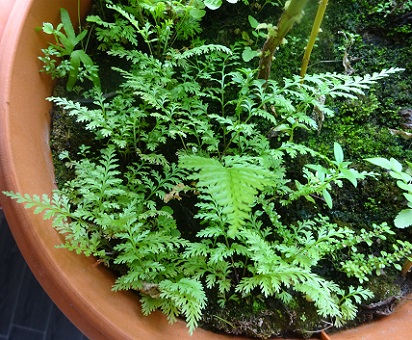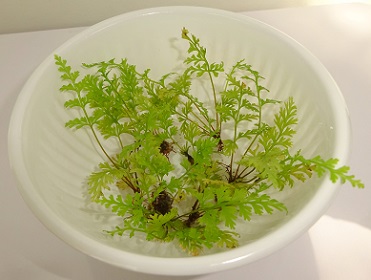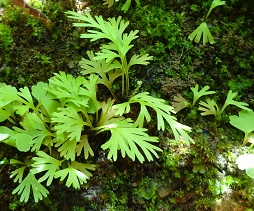| Home | Nature Weekly Index |
4 December 2016 | Silver Fern | Pityrogramma calomelanos |
 The fern season was back in my potted community along my balcony. Over last 2 months, I started to see seedlings of
Silver Fern (Pityrogramma calomelanos) started to sprout
spontaneously from a few of my pots. This relatively uncommon fern in Singapore used to be a permanent resident in my pot
before April 2015. After the painting work of the exterior of my apartment block completed in April that same year, this
fern appeared to be highly sensitive to the chemical emitted by the paint and within 2 months, not a single fern survive.
I waited for it to come back as the soil in my pot should be littered with plenty of the spores. It took more than a year
till now for the condition to be favourable again to trigger the germination of this fern. Soon, I will have lush population
of this fern again. It was easy to pull out the young fern as their roots were quite shallowly entrenched in the soil.
The fern season was back in my potted community along my balcony. Over last 2 months, I started to see seedlings of
Silver Fern (Pityrogramma calomelanos) started to sprout
spontaneously from a few of my pots. This relatively uncommon fern in Singapore used to be a permanent resident in my pot
before April 2015. After the painting work of the exterior of my apartment block completed in April that same year, this
fern appeared to be highly sensitive to the chemical emitted by the paint and within 2 months, not a single fern survive.
I waited for it to come back as the soil in my pot should be littered with plenty of the spores. It took more than a year
till now for the condition to be favourable again to trigger the germination of this fern. Soon, I will have lush population
of this fern again. It was easy to pull out the young fern as their roots were quite shallowly entrenched in the soil.
Silver Fern is a non-native fern reported to be native of Mexico, Caribbean and South America. In a post back in April 2015, I had shared its reported effect on sponging up arsenic from the soil which made it a potential natural toxic-chemical cleansing agent. The stimulant of that post was an article published in a local newspaper on 4 April 2015 on this specific property of the fern.

 I believe the results of the study might have been published 5 years back
in 2010 in the Water Science & Technology journal since I was not able to find a more recent publication on this same topic
from the group of authors. According to the objective stated in the publication, the main different of this study from the
rest that were done in the past was it compare this fern’s arsenic uptake capacity with
another fern (Brake Fern) under the same condition. The result would help to
ascertain which one was more potent in its arsenic cleansing potential. After re-read the news report after a year, I found
that it was a bit misleading in 2 aspects. Firstly, it gave an impression to the reader that the reported finding was recent
and something new. Secondly, the article title in bold and large font indicated that the fern is native to Singapore which
was incorrect. Nevertheless, the spin of the story did catch my attention.
I believe the results of the study might have been published 5 years back
in 2010 in the Water Science & Technology journal since I was not able to find a more recent publication on this same topic
from the group of authors. According to the objective stated in the publication, the main different of this study from the
rest that were done in the past was it compare this fern’s arsenic uptake capacity with
another fern (Brake Fern) under the same condition. The result would help to
ascertain which one was more potent in its arsenic cleansing potential. After re-read the news report after a year, I found
that it was a bit misleading in 2 aspects. Firstly, it gave an impression to the reader that the reported finding was recent
and something new. Secondly, the article title in bold and large font indicated that the fern is native to Singapore which
was incorrect. Nevertheless, the spin of the story did catch my attention.
The authors is undertaking another research on this fern to determine whether co-planting of the fern in rice field will reduce the uptake of arsenic by the rice crop.
Besides the above information and a few pictures of the fern, not much information on this fern in Singapore was available in the Internet.